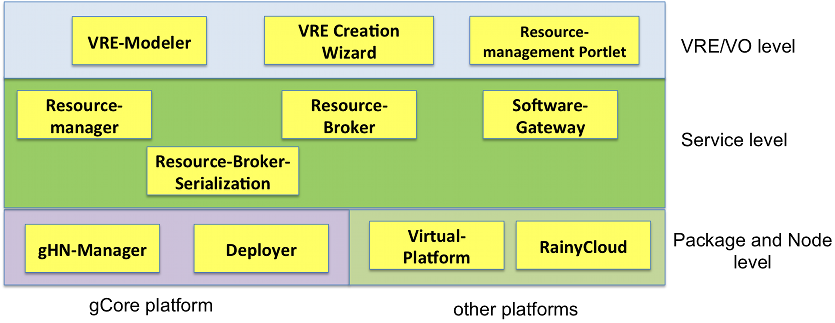Resource Management Specification
Overview
Resource Management focuses on the optimal exploitation of software and hardware resources. Software resources include a range of entities from packages ready to be deployed to already activated services, while hardware resources model anything hosting a service suitable to be exploited by the e-infrastructure.
Resource Management covers the entire lifecycle of such resources through a set of services and libraries. This document outlines their design rationale, key features, and high-level architecture as well as the opportunities they collectively offer.
Key features
- Dynamic Deployment
- First-class features for deploying gCube software and external software packaged following the gCube policies
- Optimal Resource Allocation
- ...
- Node management and Monitoring
- Tools for monitoring and managing nodes of the infrastructure are part of the resource management facilities. Local information are collected and published in the Information System as well as returned on demand. Web Service interfaces exposed by locally hosted services allow to remotely reconfigure the node upon the needs of the infrastructure.
- Scalability
- ...
- Extensible Bridging over Virtual Platforms
- A flexible model, named Virtual Platform, for transparently interfacing a potentially unlimited number of hosting environments. By extending this model, new platforms can be easily integrated in the existing management facilities and new software resources added to the infrastructure. An extension is also provided to manage Web Applications on Apache Tomcat 6.x.
- Maven Integration
- ...
- Coordination and Elastic Management
- ...
- Cloud-orientation
- Gateway to Cloud platforms with Java support
Design
Philosophy
The Data e-Infrastructure requires dynamic allocation of services and nodes and a strong capability to adapt itself to changes occurring during its operation. Components of Resource Management subsystem address these requirements.
The rationale behind the design of the presented architecture piles over the following principle:
- components must be generic with respect to the resource managed
- different components have different perceptions of the resources: some of them work at VRE/VO level, others at service level, even others at package level
- fault recovery is an essential feature, not an option
- external software has to be as transparently as possible managed in the same way of the gCube software
Architecture
- Resource-Manager
- Resource-Broker
- Resource-Broker-Serialization
- Software-Gateway
- VRE-Modeler
- gHN-Manager
- Deployer
- Virtual-Platform
- Virtual-Platform for Tomcat6
- RainyCloud
Deployment
Usually, a subsystem consists of a number of number of components. This section describes the setting governing components deployment, e.g. the hardware components where software components are expected to be deployed. In particular, two deployment scenarios should be discussed, i.e. Large deployment and Small deployment if appropriate. If it not appropriate, one deployment diagram has to be produced.
Large deployment
A deployment diagram suggesting the deployment schema that maximizes scalability should be described here.
Small deployment
A deployment diagram suggesting the "minimal" deployment schema should be described here.
Use Cases
The subsystem has been conceived to support a number of use cases moreover it will be used to serve a number of scenarios. This area will collect these "success stories".
